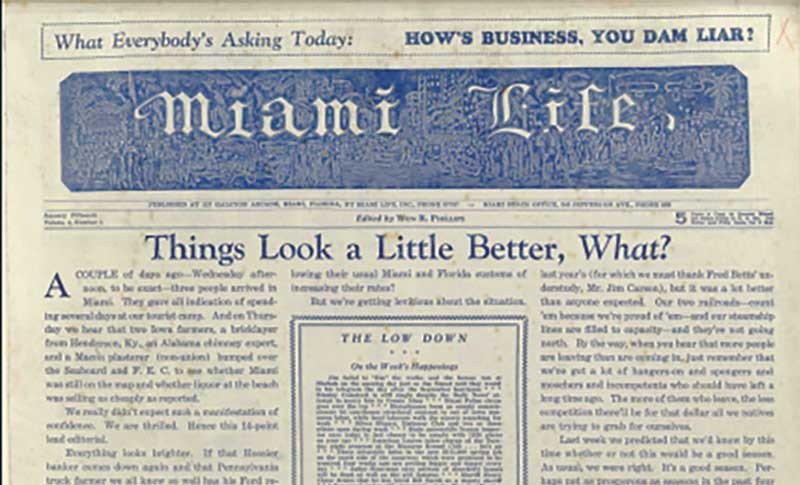As Newspapers Reinvent….
Are nonprofits key to keeping Florida informed? By Ron Cunningham Two reports of Florida marine entrepreneurism, separated by a century and a half: “The wrecking vessels are usually small schooners. They anchor within sight of each other along the Reef, and readily exchange signals when a wreck is seen. So promptly do these vessels come to the rescue they are likened to the condor that swoops down upon its prey.”
History and Heritage, Special Interest
0
Florida Newspaper History Timeline 1783–2021
Our state’s evolving life has been mirrored in the pages of our newspapers, even as the landscape of Florida journalism grew, flourished, contracted, changed, and continues to transform. This excerpt is from a chronology that is part of the University of South Florida library’s digital collection. You can also download it here. By David Shedden 1783 - 19001783 The Treaty of Paris between Great Britain and the United States ends
The power of being seen
Since 1873, Florida’s Black newspapers have advocated, informed, and reflected lives often ignored By Kenya Woodard Featured image above: Josiah Walls, born enslaved in 1842, was a man of firsts – among them, owner/publisher of Florida’s first Black newspaper and the first Black man to serve his state in the U.S. Congress. Yet when he died in 1905 in Tallahassee, no state newspaper carried his obituary. “…no more striking demonstration
An evening with Danielle Allen
Harvard University professor. Political theorist. Classicist. Author. Director of a center for ethics. Scholar on democracy, ancient Athenian and modern. By Jacki Levine Featured image above: Photographed here for a 2016 profile for Harvard Magazine, Danielle Allen is currently on leave from Harvard as she pursues the Democratic nomination for governor of Massachusetts. Her book, Democracy in the Time of Coronavirus, is due out in December. Danielle Allen’s head-turning list
Forgotten newspaper casts light on painful stories from Miami’s past
Ten years ago, Julio Capo was researching his book on Miami’s LGBTQ history before 1940 when he discovered a long-forgotten alternative weekly newspaper, Miami Life. By Janet Scherberger Featured image above: Miami Life used attention-grabbing headlines to challenge some of the most powerful state, local and national institutions of the time. “In the state archives I kept coming across references to this newspaper,” said Capo, who formerly worked in TV
A history museum with an intriguing past
Linda Kranert, museum coordinator for the Apalachicola Arsenal Museum, first saw the building back in 1993, when she was touring the grounds of Florida State Hospital in Chattahoochee after being hired as a medical unit supervisor there. By Janet Scherberger Featured image above: The history museum includes a log from the mid 1800s when the buildings were used as a penitentiary. The hospital itself was once part of a 10-building
Under the gaze of the sun
How Florida’s newspapers grew, prospered, and struggled in a state rich in stories By Gary R. Mormino and David Shedden Featured image above: Mabel Norris Reese, owner and editor of the Mount Dora Topic newspaper, was a civil rights activist as well as a journalist. Her editorial questioning the local sheriff’s shooting of two of the “Groveland Boys,” four young Black men wrongly convicted of raping a white woman in
When you leave the beaten path….
History, and a few quirky surprises, await on the backroads of our state By Ron Cunningham Featured image above: Countless red bricks remain on the old Dixie Highway as it runs from Espanola through piney woods into Putnam County. A red-brick road into the past, a lighthouse at the edge of the world, a vanishing waterfall, an improbable aluminum castle and a forgotten Civil War fortification. Those are five out-of-the-way
Twilight of the Spanish, 1780s-1821
How Florida became part of the United States By Brian R. Rucker Featured image above: Andrew Jackson Spain lost its colony of Florida to England, in 1763, after the French and Indian War/Seven Years War. By the time it reacquired Florida from Britain 20 years later with the Treaty of Paris, Spain was no longer the great European colonial power it had once been. By 1821, Spain would transfer its
Setting the stage: The early Spanish Period in Florida 1565–1763
By Judith A. Bense Featured image above: An artist’s rendering of the landing of Don Tristan de Luna at present-day Pensacola in 1559. Florida was home for thousands of years to Indigenous people who hunted, fished, and raised crops and their families along its waterways. Evidence of their communities are preserved at Crystal River near Homosassa, Lake Jackson Mounds in Tallahassee, and the Bickel Mound Site near Bradenton. But the
Recent Posts
Categories
- Art History (4)
- Book Fairs (1)
- Climate and Environment (25)
- Culture (5)
- Current Exhibitions (3)
- Documentaries (9)
- Florida Photography (12)
- Florida Talks: At Home! (32)
- Florida Women (2)
- Food and Drink (6)
- FORUM Magazine (13)
- Funding News (33)
- Grant Awards (32)
- GrantED (3)
- History and Heritage (64)
- Let's Talk About Water (4)
- Lifetime Achievement Award (11)
- Literature and Poetry (15)
- Long History of Race Relations (7)
- Military and Veterans (8)
- Past Exhibitions (23)
- Podcast (48)
- Press Releases (7)
- Special Interest (68)
- The "Humanities" (11)
- Travel & Tourism (2)
- Uncategorized (1)
- Veterans: The Telling Project (6)
- Video, Film and Documentaries (9)











